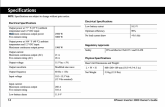I was never given a name
New Member
- Joined
- Mar 24, 2020
- Messages
- 12
Hello all! Could I run power tools (for van conversion) of this setup?
12v 280AH LiFePO4 - four 3v cells - (the ones off Alibaba everyone is talking about)
12v 4S 100A LiFePO4 BMS (the one Will is currently recommending)
3000W or 5000W inverter (maybe a Xantrex)
I don't need advice on the charging portion so I left that out. I'm assuming my limitation is the 100A BMS and the draw from the inverter. What would be the most logical/easiest/cheapest things to change to be able to run power tools? I'd like to roughly keep my power capacity 280AH similar in size.
My ideas, numbered for ease of reference: (feel free to rip them to pieces)
12v 280AH LiFePO4 - four 3v cells - (the ones off Alibaba everyone is talking about)
12v 4S 100A LiFePO4 BMS (the one Will is currently recommending)
3000W or 5000W inverter (maybe a Xantrex)
I don't need advice on the charging portion so I left that out. I'm assuming my limitation is the 100A BMS and the draw from the inverter. What would be the most logical/easiest/cheapest things to change to be able to run power tools? I'd like to roughly keep my power capacity 280AH similar in size.
My ideas, numbered for ease of reference: (feel free to rip them to pieces)
- Get smaller size cells (to keep roughly same costs) like 12 x 3v 100ah cells to make 300ah of 12v w/ the ability to draw 300A (3 x 100A BMS)
- Do a 24v system maybe 8 x 3v 200ah cells to make 200ah 24v - I don't even know the advantages there



